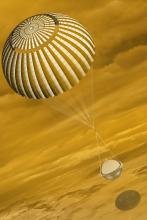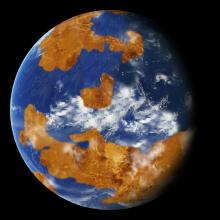Listen to today's episode of StarDate on the web the same day it airs in high-quality streaming audio without any extra ads or announcements. Choose a $8 one-month pass, or listen every day for a year for just $30.
You are here
Moon and Venus
Venus is our closest planetary neighbor, and the brightest object in the night sky except the Moon. In fact, you can see them close together tonight. Venus, the “evening star,” is close to the right of the Moon as night falls.
Despite Venus’s dramatic appearance, until spacecraft started exploring it, no one had ever seen its surface. That’s because the entire globe is blanketed by clouds. And without being able to see surface features rotating into and out of view, astronomers couldn’t even measure the length of a Venusian day.
One thing they did know is that Venus rotates backwards from the other planets. While the Sun rises in the east and sets in the west here on Earth, it’s just the opposite on Venus.
Through telescopes, astronomers could see formations in the planet’s clouds. From that, they calculated that the clouds move around the planet every four days.
Finally, in 1961, they used a giant radio telescope to bounce radar signals off the surface of Venus. By measuring a small shift in the returning waves, they found that Venus completes one turn on its axis in 225 Earth days. Because of its backward spin, though, the length of a “day” on Venus — the time from one noon to the next — is about 117 days.
The length of a day doesn’t have much effect on temperatures on Venus, though. The planet’s dense atmosphere locks in heat, so the surface temperature remains about 860 degrees Fahrenheit — day and night.
Script by Damond Benningfield






